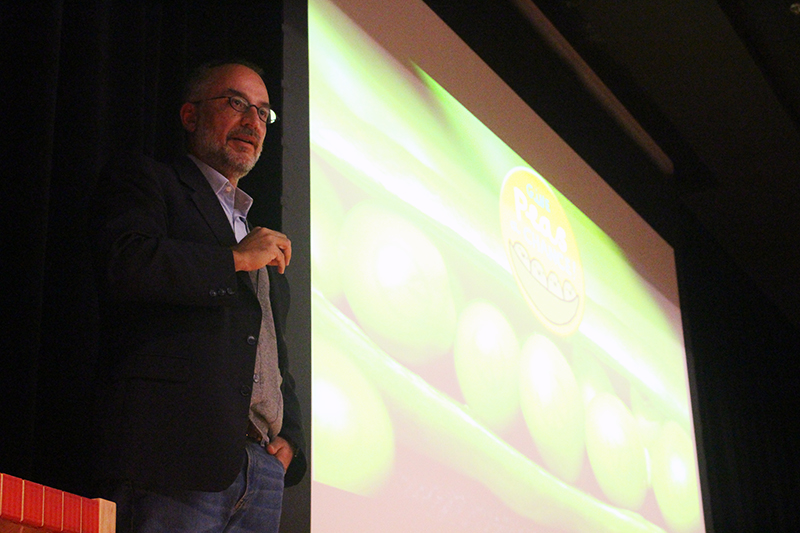
Plant physiologist Stefano Mancuso gives a lecture on plant intelligence at Ohio State on Nov. 15. Credit: Francis Pellicciaro / Assistant Multimedia Editor
In Africa in the 1980s, 3,000 kudu antelopes unexpectedly died over the course of a few weeks in an enclosed area. They were not killed by hunters or disease — they were killed by trees. Acacia trees from which the antelopes were eating leaves deliberately increased the amount of the poison tannin in their leaves until the concentration of poison was lethal.
Plant physiologist Stefano Mancuso sees this as evidence for intelligence among plants. The trees released ethylene into the air in order to warn others of danger.
Mancuso, a professor at the University of Florence and head of the International Laboratory on Plant Neurobiology, gave a lecture on plant intelligence at Ohio State on Sunday. Held in the Ohio Union’s U.S. Bank Conference Center, the lecture drew roughly 300 people.
“We realized that plants were highly underestimated in science,” Mancuso said. “One of my preferred definitions is, ‘intelligence is the ability to solve problems.’”
He said that plant intelligence is evidenced by plants’ responses to their environment, such as growing around objects and responding to rising water levels, changes in acidity and increased salinity in the soil.
Mancuso said that plants cannot run away from danger like humans and animals; they must be able to adapt in order to survive.
“(Plants) need to perceive that something is changing in the environment as early as possible,” Mancuso said. “From this point of view, plants are conscious organisms because they are aware of the environment and aware of other plants.”
Mancuso said that he is often asked if plants can feel pain, but from an evolutionary point of view, he said he would be surprised if they did.
However, plants do respond to attack, he said. The smell of cut grass is a chemical distress signal that grass plants send to warn other grass plants when their leaves are wounded. Grass plants can respond to these signals by making themselves indigestible to certain insects.
Mancuso said that in “Brilliant Green,” a book on plant intelligence he co-authored, he tries to explain in a simple way the studies of plant intelligence that he and his colleagues have conducted in the last 10 years.
In one such study conducted by Mancuso and his colleagues, mimosa plants appeared to learn how to differentiate non dangerous stimuli from harmful stimuli. The leaves of this plant fold inward when touched or shaken, so Mancuso had them dropped as well as touched. The mimosa plants stopped folding their leaves when dropped when dropping was found to be harmless, but continued to fold them when they were touched. Forty days later, the mimosa plants continued to respond that way.
Mancuso said that there are about half as many people studying plants now as there were 30 years ago, adding that people think of them as boring and scientists think that they are less likely to earn Nobel prizes for research with them.
“It is not so well understood that we humans are completely dependent on plants,” Mancuso said. “Plants will be the subjects of the next years.”
He said that issues of climate change and food safety are issues greatly concerning plant life.
“We are lacking the ability to understand that we are depending (on) plants,” Mancuso said.
Zach Beris, a graduate student studying evolution, ecology and organismal biology, attended the lecture and said that his next project is going to focus on plant communication of perceived danger.
“As a plant ecologist, it definitely makes you more aware of the kind of responses you measure in plants,” Beris said.
One of the members of the crowd asked Mancuso if it was true that he could talk to plants.
To this Mancuso replied, “I give them a lot of love, but sometimes they die.”


